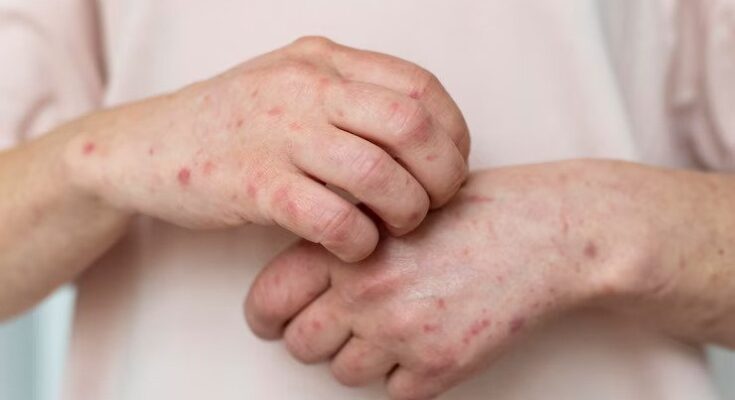Adult Still Disease Symptoms: Adult Still Disease is a rare type of inflammatory arthritis characterized by fever, rash, and joint pain. While it can occur at any age, it primarily affects people in their late twenties to early forties.
This disease can lead to chronic arthritis and other severe complications if not identified and managed promptly.
Symptoms of Adult Still Disease
The symptoms of Adult Still Disease can be nonspecific and may resemble those of other conditions. Recognizing these signs is crucial for early diagnosis and treatment:
- Fever: High fevers peaking in the late afternoon or early evening, often above 39°C (102°F).
- Rash: A salmon-pink rash that usually appears during a fever spike.
- Joint Pain: Arthritis-like joint pain affecting knees, wrists, ankles, and hands.
- Sore Throat: Severe sore throat that can be an early sign, often mistaken for an infection.
- Muscle Pain: Muscle aches associated with high fever episodes.
- Other Symptoms: Fatigue, weight loss, and lymph node enlargement.
Causes and Risk Factors
The exact cause of Adult Still Disease remains unknown. However, some studies suggest it may result from an abnormal response by the immune system, possibly triggered by an infection or environmental factors. There are no known genetic markers or specific risk factors for Adult Still Disease, but it appears to affect men and women equally.
Diagnostic Approaches
There is no single test for Adult Still Disease, making diagnosis challenging. Physicians rely on a combination of symptoms, blood tests, and imaging to diagnose the condition. Key tests and criteria include:
- Blood Tests: Elevated levels of ferritin, liver enzymes, and inflammatory markers such as C-reactive protein (CRP) and erythrocyte sedimentation rate (ESR).
- Imaging: Ultrasound or MRI to detect joint inflammation.
- Exclusion of Other Diseases: Rule out conditions with similar symptoms, such as infections, malignancies, and other rheumatic diseases.
Treatment Strategies
Treatment of Adult Still Disease focuses on managing symptoms and preventing complications:
- Nonsteroidal Anti-Inflammatory Drugs (NSAIDs): To reduce fever and alleviate joint pain.
- Corticosteroids: Often prescribed when NSAIDs are not sufficient to control symptoms.
- Disease-Modifying Antirheumatic Drugs (DMARDs): Such as methotrexate, used to decrease the immune system’s abnormal response.
- Biologic Agents: TNF inhibitors and IL-1 blockers can be effective in cases resistant to other treatments.
Managing Adult Still Disease
Living with Adult Still Disease requires a comprehensive management plan:
- Regular Monitoring: Frequent medical check-ups to monitor disease activity and adjust treatments.
- Physical Therapy: To maintain joint function and muscle strength.
- Lifestyle Modifications: Balanced diet, regular exercise, and stress management to improve overall health.
Prognosis
The course of Adult Still Disease varies. Some patients experience a single episode, others have intermittent symptoms, and some may develop chronic arthritis. Early diagnosis and aggressive treatment are key to improving the long-term outlook.
Lifestyle and home remedies
Here are ways to make the most of your health if you have adult Still disease:
Understand your medicines: Even if you have no symptoms some days, it’s important to take your medicines as your care provider recommends. Controlling inflammation helps reduce the risk of complications.
Supplement your diet: If you’re taking high doses of prednisone, talk to your care provider about taking more calcium and vitamin D supplements to help prevent osteoporosis.
Keep moving: Although you might not want to work out if your joints ache, exercise is recommended for all types of arthritis. Exercise can help you keep your range of motion and relieve pain and stiffness.
Preparing for your appointment
You’re likely to seek advice from your primary care provider, but you may receive a referral to a rheumatologist. A rheumatologist is a doctor who specializes in joint diseases.
Here’s some information to help you get ready for your appointment.
What you can do
When you make the appointment, ask if there’s anything you need to do in advance, such as fast for a specific test. Make a list of:
- Your symptoms, including when they started and how often they flare.
- Key medical information, including any other diagnosed health conditions.
- All medicines, vitamins and supplements you take, including the doses.
- Questions to ask your doctor.
Take a family member or friend along, if possible, to help you remember the information you get.
For adult Still disease, basic questions to ask your doctor include:
- What’s likely causing my symptoms?
- What are other possible causes?
- What tests do I need?
- Is my condition likely temporary or chronic?
- What’s the best course of action?
- What are the alternatives to the approach you’re suggesting?
- I have these other health conditions. How can I best manage them together?
- Are there restrictions I need to follow?
- Should I see a specialist?
- Are there brochures or other printed material I can have? What websites do you recommend?
Don’t hesitate to ask other questions.
What to expect from your doctor
Your health care provider is likely to ask you questions, such as:
- When did your symptoms begin?
- Do your symptoms come and go, or are they continuous?
- When are your symptoms most likely to flare?
- What treatments or self-care measures have you tried?
- Have any treatments or self-care measures helped?
- Have you been diagnosed with any other medical conditions?
Conclusion
Recognizing the significance of awareness, early diagnosis, and prompt treatment of Adult Still’s Disease (ASD) is essential for altering the course of this rare inflammatory ailment.
ASD, often presenting with fever, joint pain, and a distinctive salmon-colored rash, can lead to severe complications if not addressed timely.
Therefore, educating healthcare providers and the public about the symptoms and potential risks associated with Adult Still’s Disease is critical.



